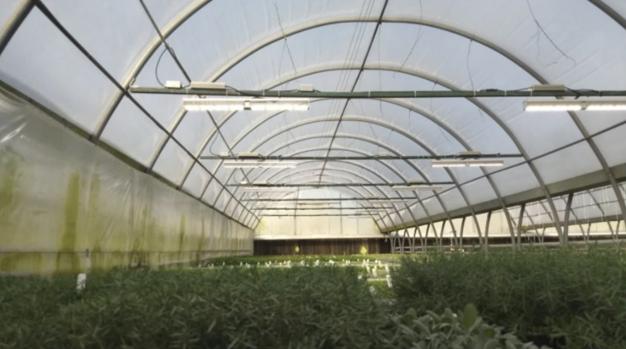“Candidus lighting controllers can be used to control HPS and LED systems alike, with an ROI of less than a year,” says Dr. Erico Mattos, co-founder and chief executive officer of lighting control company Candidus.
Spending 2–3 years developing its dynamic controllers for horticultural lighting, Candidus was established in 2017 and has been in commercialization mode for more than a year. Candidus light controllers monitor weather conditions and adjust greenhouse supplemental lighting based on current conditions, forecasted conditions, and crop requirements. The controllers also allow growers to create light zones within the greenhouse and apply different photoperiods, DLI targets, supplemental light intensities, daylength extension, and night interruption. As Erico explains, Candidus controllers are unique in that they dynamically change the setpoints for lighting control. Conventional controllers operate by turning lights on when ambient light conditions drop below a minimum threshold, whereas Candidus adjust the thresholds based on the lighting conditions in the greenhouse. This, as Erico explains, is to ensure that the crop always receives the targeted DLI, while reducing energy consumption.

On a similar note, Candidus has recently added a “DLI carryover” option to its controller. This feature takes advantage of sunny days, with more than the required light. The controller rolls the ‘excess DLI’ over to the following day, lowering the DLI target, so less lighting is used following sunny days. The “DLI carryover” concept was developed through research by Candidus co-founder Dr. Marc van Iersel at the University of Georgia, whose research demonstrated that following a high-light day, less light could be provided on the following day, with no impact on the crop. Candidus currently recommends crop-specific light carryovers, but growers can ultimately decide how much ‘excess light’ they want to carry over to the next day.
Providing agnostic control solutions
When asked about how Candidus can adapt its controllers to the numerous horticultural lighting systems currently on the market, Erico explains that regardless of the company, the technical aspect mostly boils down to the same thing.
“Everything comes down to 4-5 communication protocols. Most LEDs have drivers that accept a 0-10 VDC dimming signal, while some use digital communication protocols. HPS fixtures are fairly simple because it is a simple on/off, but growers are still able to organize all of these into lighting zones, play with the photoperiod, and set DLI targets” says Erico. ‘By using a powerful microcomputer as the brain of the controller, we can provide whatever signal the lights require.’
Candidus has developed a proprietary signal amplifier to ensure that the controller’s signal reaches each light fixture, regardless of the number of fixtures. Further, the advent of digital controllers has allowed Candidus to send a single signal which lights can then propagate among themselves. Candidus’ flexibility allows the company to control any 3rd party light fixture and provide optimal lighting conditions for any crop.
“We provide a flexible tool for the grower so that they can manage their lighting system however they want. They are always in control; we just provide the tool to make it easy and efficient” Erico explains.
USDA-supported commercial trials
Candidus has multiple projects in the pipeline, two of which are funded by the USDA to demonstrate the energy savings associated with dynamic lighting controllers in commercial greenhouses. In partnership with Cornell University, Candidus has received grant funding from the USDA through its Specialty Crop Block Grant Program (SCBGP) to evaluate cost savings in eight commercial greenhouses in New York state. The eight greenhouses have already been selected and will soon begin trialing the lighting controllers.

Further, the USDA’s Natural Resources Conservation Service (NRCS) awarded Candidus a conservation innovation grant to implement its lighting controllers in 12 commercial greenhouses in California, Virginia, and Michigan. The company has secured the participation of 6 greenhouses to date and invites greenhouse growers in these states to participate in the study.
The goal of the project is to monitor the energy costs for lighting, comparing a greenhouse section equipped with a Candidus controller and a section without the controller. As Erico explains, the program provides significant incentives for the growers.
“The greenhouse receives the controller free of charge, as well as $2,000 for installation and $2,000 per year for three years for their space and time. We’re looking to use an area of 2,000 ft2, so it is a low-risk study and they get to keep the controller,” says Erico.
According to Erico, recruiting greenhouses in Virginia and Michigan has been relatively easy due to the company’s close collaboration with Virginia Tech and Michigan State University. Outreach has been more challenging in California, so Erico encourages any California greenhouses to contact Candidus if they are interested in participating. Since Candidus controllers can be used for both HPS and LED lights, the company is welcoming participation from any greenhouses with supplemental lighting in the targeted regions. The results from these projects will be used to encourage adoption and guide the development of energy incentives for advanced lighting controllers.
Aside from these projects, Candidus also will be sharing case studies on the company website in the coming months.
For more information:
Erico Mattos
CEO and co-founder
Candidus
https://candidus.us/
[email protected]
